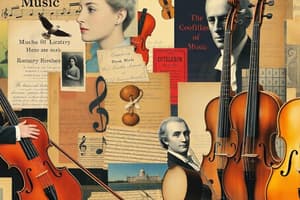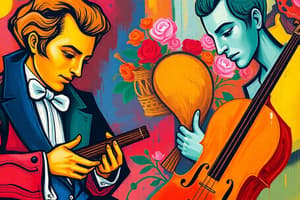Podcast
Questions and Answers
Which of the following composers are from the Medieval and Renaissance periods? (Select all that apply)
Which of the following composers are from the Medieval and Renaissance periods? (Select all that apply)
- Palestrina (correct)
- Bingen (correct)
- Machaut (correct)
- Monteverdi (correct)
Which composers are associated with the Baroque period? (Select all that apply)
Which composers are associated with the Baroque period? (Select all that apply)
- Vivaldi (correct)
- Bach (correct)
- Purcell (correct)
- Handel (correct)
Which of the following composers are from the Classical period? (Select all that apply)
Which of the following composers are from the Classical period? (Select all that apply)
- Beethoven (correct)
- Mozart (correct)
- Haydn (correct)
Which of the following composers belong to the Romantic period? (Select all that apply)
Which of the following composers belong to the Romantic period? (Select all that apply)
Which composers are considered Modernist? (Select all that apply)
Which composers are considered Modernist? (Select all that apply)
Which of the following composers are classified as Post-Modern? (Select all that apply)
Which of the following composers are classified as Post-Modern? (Select all that apply)
What is the date range of the Middle Age period?
What is the date range of the Middle Age period?
What is the date range of the Renaissance period?
What is the date range of the Renaissance period?
What is the date range of the Baroque period?
What is the date range of the Baroque period?
What is the date range of the Classical period?
What is the date range of the Classical period?
What is the date range of the Romantic period?
What is the date range of the Romantic period?
What is the date range of the Post-Romantic and Impressionist period?
What is the date range of the Post-Romantic and Impressionist period?
What does 'conjunct' refer to in music?
What does 'conjunct' refer to in music?
What does 'disjunct' refer to in music?
What does 'disjunct' refer to in music?
What is an interval in music?
What is an interval in music?
What is range in music?
What is range in music?
What is contour in music?
What is contour in music?
What is the definition of 'Development' in music?
What is the definition of 'Development' in music?
What is 'Recapitulation'?
What is 'Recapitulation'?
What is 'Sonata-Allegro Form'?
What is 'Sonata-Allegro Form'?
Define 'Coda'.
Define 'Coda'.
What does 'Cadenza' refer to?
What does 'Cadenza' refer to?
What is a 'Concerto'?
What is a 'Concerto'?
What characterizes 'Sonata'?
What characterizes 'Sonata'?
Define 'Modified Strophic Form'.
Define 'Modified Strophic Form'.
Rubato refers to strict adherence to rhythm in music.
Rubato refers to strict adherence to rhythm in music.
What is a 'Leitmotif'?
What is a 'Leitmotif'?
What does 'Music Drama' refer to?
What does 'Music Drama' refer to?
Define 'Impressionism' in music.
Define 'Impressionism' in music.
What is 'Polyharmony'?
What is 'Polyharmony'?
What is 'Twelve-tone music'?
What is 'Twelve-tone music'?
Define 'Avant-Garde'.
Define 'Avant-Garde'.
What does 'Futurism' emphasize?
What does 'Futurism' emphasize?
What is a 'Tone Cluster'?
What is a 'Tone Cluster'?
What is 'Source Music'?
What is 'Source Music'?
Define 'Minimalist' music.
Define 'Minimalist' music.
What does meter refer to in music?
What does meter refer to in music?
What is polyrhythm?
What is polyrhythm?
What is syncopation?
What is syncopation?
What characterizes compound meter?
What characterizes compound meter?
What is duple meter?
What is duple meter?
Define simple meter.
Define simple meter.
What is triple meter?
What is triple meter?
What does consonance refer to in music?
What does consonance refer to in music?
What is tonality?
What is tonality?
Define a chord.
Define a chord.
What is a triad?
What is a triad?
What is modulation?
What is modulation?
Define chromatic in a musical context.
Define chromatic in a musical context.
What is a flat sign?
What is a flat sign?
What does a half step refer to?
What does a half step refer to?
What is a sharp sign?
What is a sharp sign?
Define a whole step.
Define a whole step.
What is a major scale?
What is a major scale?
What is a minor scale?
What is a minor scale?
What is ternary form?
What is ternary form?
Define a motive in music.
Define a motive in music.
What is a sequence in music?
What is a sequence in music?
What is a theme in music?
What is a theme in music?
What is strophic form?
What is strophic form?
Define through-composed in music.
Define through-composed in music.
What are dynamics in music?
What are dynamics in music?
What is the definition of Tempo?
What is the definition of Tempo?
What does Neumatic refer to?
What does Neumatic refer to?
What is the Syllabic style?
What is the Syllabic style?
What does Word-Painting mean in music?
What does Word-Painting mean in music?
What is Melismatic style?
What is Melismatic style?
What is a Membranophone?
What is a Membranophone?
What defines an Aerophone?
What defines an Aerophone?
What is a Chordophone?
What is a Chordophone?
What is an Idiophone?
What is an Idiophone?
What is a Fugue?
What is a Fugue?
What is Chamber Music?
What is Chamber Music?
What does A cappella refer to?
What does A cappella refer to?
What defines a Symphony?
What defines a Symphony?
What is Gregorian Chant?
What is Gregorian Chant?
What is an Overture?
What is an Overture?
What does Opera refer to?
What does Opera refer to?
What is a Libretto?
What is a Libretto?
What is Recitative?
What is Recitative?
What defines an Oratorio?
What defines an Oratorio?
What is Program Music?
What is Program Music?
What does Exposition refer to in music?
What does Exposition refer to in music?
What is Theme and Variations?
What is Theme and Variations?
What is Absolute Music?
What is Absolute Music?
Flashcards are hidden until you start studying
Study Notes
Composers across Periods
- Medieval and Renaissance: Key composers include Hildegard von Bingen, Guillaume de Machaut, Giovanni Pierluigi da Palestrina, and Claudio Monteverdi.
- Baroque Era: Notable figures are Henry Purcell, Antonio Vivaldi, Johann Sebastian Bach, and George Frideric Handel.
- Classical Period: Prominent composers are Joseph Haydn, Wolfgang Amadeus Mozart, and Ludwig van Beethoven.
- Romantic Period: Influential composers include Johannes Brahms, Frédéric Chopin, Claude Debussy, Franz Schubert, Pyotr Ilyich Tchaikovsky, Giuseppe Verdi, and Richard Wagner.
- Modernist Era: Key composers comprise Aaron Copland, George Gershwin, William Grant Still, and Igor Stravinsky.
- Post-Modern Period: Notable composers are John Adams, Leonard Bernstein, John Cage, George Crumb, Philip Glass, and John Williams.
Historical Period Dates
- Middle Ages: 400-1450.
- Renaissance: 1450-1600.
- Baroque: 1600-1750.
- Classical: 1750-1825.
- Romantic: 1820-1900.
- Post-Romantic and Impressionism: 1890-1915.
Musical Concepts
- Conjunct Melody: Smooth melodies with small interval movements.
- Disjunct Melody: Melodies with larger leaps and disconnected intervals.
- Interval: The gap between two pitches.
- Range: The span from the lowest to the highest note in a melody or instrument.
- Contour: The shape of a melodic line, indicating movement up or down.
Rhythm and Meter
- Meter: Organization of beats into regular patterns, represented as measures.
- Polyrhythm: Multiple rhythmic patterns or meters played simultaneously.
- Syncopation: Shifting emphasis from strong to weak beats.
- Compound Meter: A main beat divided into three subdivisions.
- Duple Meter: A basic rhythm with two beats per measure.
- Simple Meter: Basic rhythms with beats divided into two.
- Triple Meter: A basic rhythm with three beats per measure.
Harmony and Tonality
- Consonance: Harmonious combinations producing stability.
- Tonality: Organization around a home pitch (tonic) based on scales.
- Chord: A harmony composed of three or more pitches.
- Triad: A three-pitch chord using alternate scale notes.
- Modulation: Transition from one key to another.
- Chromatic Scale: A scale made up of all twelve pitches of the octave.
Musical Structures
- Ternary Form: A three-part musical structure (A-B-A).
- Motive: A short musical idea or theme.
- Theme: A melodic idea that serves as a building block in music.
- Strophic Form: Repeating music for each stanza of lyrics.
- Through-Composed: Continuous music with no large repeated sections.
Dynamics and Expression
- Dynamics: Variations in loudness or softness in music.
- Tempo: The speed of music.
- Neumatic: A melodic style with a few notes per syllable.
- Syllabic: One note per syllable in melody.
- Melismatic: Multiple notes per single syllable.
Instrument Types
- Membranophone: Instruments producing sound from membranes (e.g., drums).
- Aerophone: Instruments using air to create sound (e.g., flutes).
- Chordophone: Stringed instruments producing sound through vibrating strings.
- Idiophone: Instruments that make sound by vibrating without air or strings (e.g., xylophones).
Specialized Musical Forms
- Fugue: A polyphonic composition with imitative counterpoint.
- Chamber Music: Ensemble music for small groups.
- A cappella: Vocal music performed without instruments.
- Symphony: A large orchestral work typically in four movements.
- Gregorian Chant: Monophonic liturgical chant of the Roman Catholic Church.
Types of Composition
- Oratorio: A large-scale vocal work on religious themes, performed without staging.
- Recitative: A solo vocal style that follows speech rhythms.
- Program Music: Instrumental music with associations to stories or images.
Musical Forms and Procedures
- Sonata-Allegro Form: Structure featuring exposition, development, and recapitulation.
- Coda: Conclusion section of a piece of music.
- Cadenza: An elaborate solo passage in music, typically at the end of a section.
Contemporary Styles
- Minimalist: Style repeating short patterns with few variations.
- Twelve-tone Music: A method using all twelve pitches with no tonal center.
- Avant-Garde: Innovative styles in the arts during the early twentieth century.
- Futurism: A movement emphasizing technology and dynamism.
- Impressionism: Music emphasizing rich tone colors and vague harmonies.
Studying That Suits You
Use AI to generate personalized quizzes and flashcards to suit your learning preferences.




